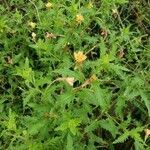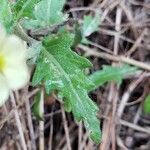Erect, often rank, annual, usually with many branches from the base, these often decumbent and up to 40 cm. long. Plants strigulose and densely villous above, especially in the inflorescence. Leaves 1-8 cm. long, sinuate-dentate or sinuate-pinnatifid, more rarely subentire, lanceolate; lower leaves petiolate, the upper ones sessile. Inflorescence erect, the villous buds individually deflexed from it before opening; flowers borne in the axils of much reduced leaves. Flowers opening near sunset. Floral tube 8-10 mm long. Sepals 6-8 mm long, with slender free tips c. 1 mm long. Petals 5-7 mm long, bright yellow, fading reddish. Anthers 2-3 mm long, the filaments 3-6 mm long. Style surrounded by the anthers at anthesis; stigma with linear lobes c. 2 mm long. Capsule cylindric, 1.5-3 cm. long, not winged, subsessile. Seeds c. 1 mm long, light brown, obovoid, coarsely and conspicuously pitted.
Annual, simple or branched from the base, decumbent to erect, 1–4(–8) dm; lvs oblanceolate to oblong or lanceolate, 3–8 cm, tapering to the base, prominently sinuate-dentate to pinnatifid, green, sparsely puberulent to glabrous above; fls few, sessile in the axils of the scarcely reduced upper lvs, not forming a distinct spike; hypanthium hirsute, 1.5–3.5 cm; sep 6–12 mm, reflexed separately or connivent; pet 5–18 mm; fr linear, straight or curved, 1.5–3.5 cm; seeds thick-ellipsoid, pale brown, conspicuously pitted; 2n=14. Dry, usually sandy soil; Me. to S.D., s. to S. Amer. May–Oct. Our plants, as here described, are var. laciniata.
Annual or sometimes short-lived perennial herb to c. 50 cm high with a taproot. Stems 1 to several, usually with conspicuous spreading hairs and/or with appressed hairs, glandular hairy in upper parts. Basal leaves rosetted, narrowly oblanceolate, 4–15 cm long; cauline leaves usually oblanceolate, 2–10 cm long, entire to sinuate-pinnatifid or-dentate, acute. Flowers in upper axils. Hypanthium slender, 1.2–3.5 cm long. Sepals 5–15 mm long, sometimes failing to separate. Petals 5–22 mm long, yellow, ageing reddish. Capsule subcylindrical, somewhat curved, 2–5 cm long, 2–4 mm wide, with long dense spreading and short appressed hairs.
Erect, often rank annual, 0.2-0.6 m high; often with many stems from base; upper parts strigillose to densely villous. Leaves lanceolate, base attenuate, apex acute to rounded; lower leaves petiolate. Flowers borne in axils of reduced leaves, buds curved upwards. Floral tube up to 35 mm long. Sepals with slender, free tips 0.5-3.0 mm long. Petals 5-25 mm long, fading reddish. Flowering time Aug.-Dec. Fruit a capsule, up to 15 x 4 mm, cylindric, not winged, subsessile. Seeds ± 1 mm long, obovoid, coarsely pitted, light brown.
Annual herb, up to 300 mm high; strigillose, densely villous and glandular-pubescent. Stems erect. Leaves petiolate and sessile; narrowly ovate, 10-80 mm long, margins sinuate-dentate or sinuate-pinnatifid, or rarely subentire. Flowers: buds curved upward; floral tube 12-35 mm long; sepals 6-8 mm long; petals 5-7 mm long, bright yellow, fading reddish; Oct., Nov., Feb. Fruit cylindrical, 15-50 mm long; seeds coarsely and conspicuously pitted.
Annual herb, up to 300 mm tall. Leaves sinuate-dentate or sinuate-pinnatifid, or rarely subentire. Sepals 6-8 mm long. Petals 5-7 mm long. Capsule cylindrical; seeds coarsely and conspicuously pitted. Flowers bright yellow, fading reddish.








